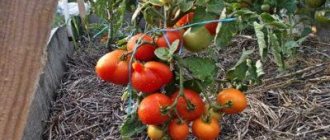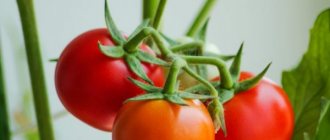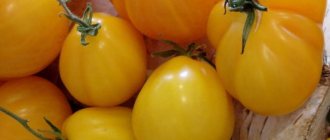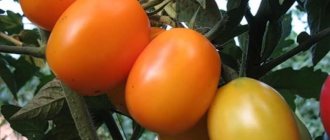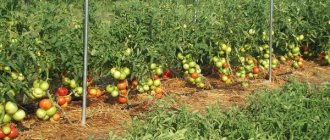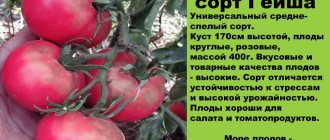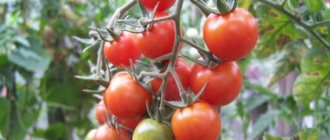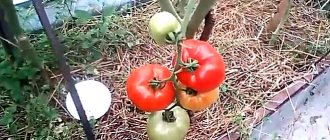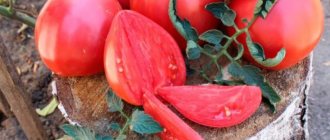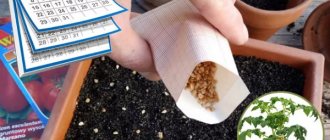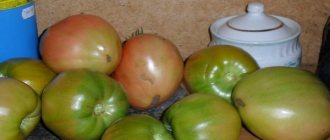Tomato Voskhod was the result of research and experiments of Russian scientists. The variety is part of the “Gardens of Russia” collection, which includes new promising species and the most productive garden crops.
Sunrise, or as it is often called by gardeners, Dawn, is a hybrid species of medium ripening. It takes 90 days from the appearance of the first shoots to the ripening of the first tomato.
The description classifies the plant as a determinate species, which is characterized by compactness and moderate formation of a mass of greenery. The average height of the bush reaches 60-80 cm. The leaf blades have a simple structure and a characteristic green color. The variety is a universal type of tomato, as it is suitable for growing in open ground, in greenhouses, under film and even in flowerpots.
The manufacturer recommends growing the plant in one or two bushes.
Description of the variety
Fruit:
- Round, slightly flattened, medium in size, with slight ribbing at the stalk;
- With dense, not hard skin;
- Rich red color;
- The pulp is juicy, with moderate density and a small number of seeds;
- The average weight varies from 50 to 100 grams. However, in greenhouses you can get fruits weighing 200 grams.
Bushes:
- Determinate, compact plant with moderate formation of green mass;
- On average it reaches a height of 60 to 80 cm;
- The leaves are medium-sized, simple, dark green in color;
- The inflorescence is simple.
Fruit characteristics
The tomato pulp is moderately dense and juicy, with a small number of seeds. Even tomatoes that ripen for a long time do not acquire excessive skin density.
Description of fruits:
- tomatoes are characterized by medium size;
- the shape resembles the appearance of an egg;
- the stalk is characterized by ribbing;
- The average weight of a tomato varies between 50-100 grams.
When grown in greenhouse conditions, the fruit size can reach 200 grams. The taste characteristics of the variety indicate the presence of a pleasant sweetish taste. Young vegetables have a light green color, which over time turns into a rich red color.
Sunrise tomatoes are suitable for canning whole. Thanks to their thick skin, which can withstand temperatures well, tomatoes do not crack and look aesthetically pleasing in a jar.
Tomatoes can be used to prepare various tomato-containing preparations:
- sauces;
- tomato puree;
- juices;
- seasonings for soups.
Harvested vegetables can be stored for a long time. Tomatoes can be cut unripe and left for further ripening in a warm room.
Growing tomatoes
For the convenience of growing hybrids, the seedling method is used.
How to prepare seeds?
Seed material does not need to be disinfected, since it undergoes all necessary procedures before sale. However, to increase germination, seeds are treated using a growth stimulator.
Sowing seed material
Basic recommendations for sowing:
- Sowing of seed material for seedlings begins two months before planting in a permanent place;
- The soil mixture should include garden or turf soil with humus. You can increase the nutritional value of the soil by adding wood ash;
- Planting grooves are made at intervals of three centimeters and a depth of 1 cm. Seeds are sown at a distance of 2-2.5 cm from each other. Cover the top with a small layer of soil and sprinkle with water;
- To create a greenhouse effect, containers with seedlings are covered with film. Seeds germinate successfully at temperatures from +23 to +25 ºС;
- As soon as the first shoots appear, the film is removed and the containers are placed on the windowsill on the south side or under lamps;
- As soon as the first pair of true leaves appears, begin picking, and also fertilize using a complete complex fertilizer;
- To prevent the stretching of seedlings and create optimal conditions for the development of the root system, after the emergence of shoots, the temperature for the first 2-3 days is reduced to +15-18 ºС during the daytime and to +10-12 ºС at night;
- Before planting seedlings in a permanent place, hardening of the seedlings begins. For this purpose, the containers are taken out into the open air for a couple of hours, gradually increasing the time the seedlings spend outside.
How to grow cherry tomatoes? Cultivation secrets:
Rules for planting seedlings
How to plant seedlings correctly:
- First of all, prepare the beds. With the onset of spring, mineral fertilizers are applied to the soil: per 1 m2 - 60 grams of superphosphate, 60 grams of potassium sulfate and 40 grams of ammonium sulfate. After applying fertilizers, the soil is loosened;
- Prepare planting grooves with a width of 20 to 25 cm and a depth of 15 to 20 cm. When planting in several lines on wide beds, the distance between the planting grooves should be at least 70 cm;
- The tomato hybrid is planted in soil heated to +12 - +14 ºС. Before planting, add two tablespoons of “Borofoska” to each planting hole, mix it with the soil and spill it with a solution of “Trichodermina” + “Baikal” or a solution of “Fitosporin” + “Baikal”. The holes are covered from above to avoid moisture evaporation;
HELP: It is advisable to plant in cloudy weather. Before planting, seedlings are not watered for two to three days. Immediately before planting, the planting holes are shed generously with warm water, since the next watering will occur only after 10 days. Seedlings are planted in planting holes at a distance of 40-50 cm from each other.
Advantages of the Spring F1 tomato and rules for growing a hybrid variety
Siberian breeders have once again pleased consumers with a new hybrid of nightshade crop. This is a Spring F1 tomato. It is easy to maintain and highly adaptable to soil and weather conditions.
The Spring tomato variety is grown in greenhouses, hotbeds and open ground. In almost all regions it takes root well and produces a good harvest. Any vegetable grower first of all strives to grow a plant not only with large fruits, but also with excellent taste. This is exactly what the Vesna variety is. The tomatoes have a pronounced taste, with a small amount of acid, the flesh is sugary and juicy.
Reviews received from gardeners with experience in growing the Vesna variety are only positive.
The main advantages of the variety
The bush has a small growth, reaching a maximum of 50-60 cm in height. The growing season is about 90-100 days. The plant has a strong trunk and a powerful root system, which goes 1.5-2 m deep into the ground, thanks to which it helps the tomato not shed foliage and fruits during periods of natural vagaries.
The inflorescence of Spring tomatoes is ordinary. The first brush is formed after 6-7 leaves. Fruits are set in 5-7 pieces. for 1 brush. The bush needs a garter and additional support, especially during the ripening period of fruits that gain weight.
The leaves are slightly elongated and have a pronounced corrugated pattern, dark green in color, and do not fill the bush very densely. The productivity of the Spring tomato is high and stable. From 1 bush over the summer you can remove up to 5 kg of fruit.
Description of the Spring tomato fruit:
Tomatoes have a beautiful, even red color. Their peel is dense and smooth, firmly protecting the pulp from sunlight and cracking. Tomatoes weigh from 150 to 200 g. The shape of the fruit is round with slight ribbing. The pulp has 4 chambers filled with small seeds. The taste of the fruit is not bland, rich with a subtle spicy aftertaste. Vesna variety tomatoes are perfect for preparing tomato products and eating fresh. The harvest is stored for a long time. The tomato is suitable for transportation over long distances without losing its presentation. Tomatoes can be picked from the bush at the ripening stage
It is important that the fruits acquire a light milky color. Then they ripen well in a warm room.
The peculiarities of the variety are its strong immunity to tobacco mosaic and late blight. Vesna tomatoes are not demanding to care for. To grow these tomatoes, it is enough to know the basic rules of agricultural technology. If all these requirements are met correctly, the plant will reward you with rich and high-quality harvests until the fall.
Growing rules
Typically, the characteristics and description of the variety are placed by the manufacturer on the seed package. It also shows a schedule for planting seeds for seedlings and planting them in open ground.
Sowing tomato seeds Spring for seedlings is carried out in the spring. The optimal time for planting is considered to be the second half of March. Before planting, seeds must be treated in a manganese solution. Its concentration should be weak. The material is immersed in liquid for 30 minutes, after which it is allowed to dry thoroughly. To activate growth, you can use special stimulants.
Soil for seedlings is prepared from the following components:
- coarse river sand;
- turf land;
- peat.
All components are mixed and moistened. A shallow container is suitable for growing seedlings. The soil in it is lightly compacted and holes are made 1.5-2 cm deep. They are covered with soil on top, but not compacted.
It is important to water immediately and cover the container with film. Seedlings are kept in a room where the temperature is not lower than +22…+25°C
The film is removed with the appearance of the first shoots. Water the seedlings with warm and settled water from a spray bottle. It is important not to over-moisten the soil and not cause moisture stagnation.
When 2 leaves appear on the sprouts, a dive is performed. You can plant seedlings directly in peat pots.
Before planting, seedlings can be hardened off. To do this, in the morning and evening, it is taken outside for 1 hour. This process begins 15 days before planting.
The seedlings are ready for planting when they have 6-7 leaves and 1 inflorescence. The beds need to be fertilized before planting. Some gardeners use complex mineral fertilizers for this, while others prefer ordinary humus.
Bushes are planted at the rate of 3-4 plants per 1 m². The holes should be immediately mulched with small sawdust or straw. At first, it is necessary to water the beds only with settled water. After 1 week, the seedlings need to be fed with mineral fertilizer. During the growing process, you should perform pinching and form a bush of 1-2 stems.
Bush care
Basic measures for further care:
- The hybrid tomato is fed for the first time 10 days after planting in a permanent place. They use ammonium sulfate fertilizer, which contains sulfur, which is a preventive agent against diseases, and nitrogen, which serves as a source of building material for the construction of new plant cells. To prepare the solution, you need to dilute 1-2 tablespoons of fertilizer in a bucket of water. The prepared solution is used to water the bushes near the furrows along the entire perimeter of the beds. It will take 2-4 liters for each bush. The number of waterings is determined by the air temperature: on hot days, 4 liters are used for watering;
Also, after 10 days, the tomato is completely rooted in the soil and the root and above-ground parts of the plant begin to grow. Therefore, the bushes need to be tied up.
- After 10 days, the formation of the plant begins. To get the largest possible fruits, the bush is formed into only one stem, with all growing stepsons removed.
Tomato sunrise f1 description
The Spring tomato is endowed with a large number of positive yield qualities. The first thing that gardeners noted was that, regardless of weather conditions, a tomato always shows a high mass of crop harvested per unit area. So, from 1 sq. m. a yield of about 17 kg was recorded. The fruits were also highly appreciated, the value of which lies in the following indicators:
- Tomatoes have an attractive round shape with smooth skin.
- On average, the weight of one fruit varies from 200 to 300 grams.
- Tomatoes are endowed with a rich sweetish taste with a slight sourness.
- Juicy, fleshy pulp with 4 chambers contains a small amount of seeds.
- The fruits are resistant to cracking and do not deform during long-distance transportation.
- Resistance to black rot and long shelf life are noted.
The universal qualities of the fruit allow them to be successfully used in processing and preservation, but they still exhibit a brighter taste when fresh.
If you want to be guaranteed excellent yields of high-quality tomatoes year after year, there is no need to experiment with overseas varieties. Domestic tomatoes, such as the famous Vostok F1 variety, grow best on our land. This variety is absolutely reliable.
Whether it’s rain or drought, this tomato will always produce a decent harvest of delicious, beautiful and large tomatoes.
Description
The tomato variety “Vostok F1” is one of the ten mid-early varieties with the best yield and fruit quality indicators. “East” was selected at the Uzbek Research Institute of Vegetable, Melon and Potato Crops. The variety was developed in several stages: selection for offspring, selection with evaluation. The variety comes directly from the collection sample of the Curly variety. The variety was zoned back in 1977.
Vostok F1 was included in the State Register of the Russian Federation in 2015.
Farmers recommend growing Vostok in open ground in the southern regions of our country and neighboring countries. In mid-latitudes and especially in the north, the best performance of this variety will be when grown in greenhouse conditions.
Characteristic
Hybrid Vostok F1 is an early ripening tomato variety. The period of final ripening of fruits is 100 days from the date of appearance of the first seedlings.
Vostok is a determinate tomato, not standard, compact. In open ground, bushes often reach 60-75 centimeters in height; in greenhouse conditions, plants grow up to one meter. There are few leaves on the bush, the leaves are dark green, long, slightly rough. The variety gives the best yield indicators when the plant is formed into two or three stems.
The fruits of the East have a round shape. They grow together on the hand, all of the same size. The peel is glossy, thick, bright red during the period of biological maturity. The surface of the tomatoes is smooth, slightly ribbed at the base.
The pulp is juicy, not dense, fleshy, with a large content of seeds. The weight of one fruit varies between 200 -250 grams. It has an excellent sweetish taste for a hybrid.
Due to the fact that the plant bears fruit early enough, it is rarely affected by the most dangerous tomato diseases, such as late blight.
Vostok, when grown correctly, shows excellent productivity. Usually, if agricultural standards are observed, up to 7-8 kilograms of high-quality fruits can be collected from one bush. One bush can form up to 12 fruit ovaries.
Tomatoes are stored well and can withstand the load adequately during transportation.
Tomatoes of this variety are consumed in various forms: good for canning, tomatoes, juices, and of course for fresh consumption.
- very high yield;
- good taste for a hybrid variety;
- the variety is resistant to heat and drought;
- optimal fruit size;
- early harvest;
- iron immunity to various diseases.
This variety has one drawback, but it is significant: seeds collected from productive tomatoes will not have the same qualities as purchased seeds. This is the lot of all hybrid varieties. Therefore, Vostok variety seeds must be purchased annually.
Seeds for seedlings are sown in March in large wooden boxes or peat cups. After 7-10 days, under the right environmental conditions, the first shoots appear.
When two or three open leaves appear on the seedlings, the seedlings are pruned. Picking must be done very carefully, since the tomato root system is very fragile and any impact can destroy the plant. The Vostok variety is distinguished by excellent seed germination, reaching almost 100%.
If the greenhouse is heated, then the seedlings can be planted in a permanent place at the end of April. By this time, the first flower ovaries will appear on the bushes. However, it is worth remembering that the earth must be warmed up by at least 16 degrees. You can feed tomatoes with rotted manure or bird droppings.
Planting in open ground is carried out at the end of May, when the weather is at 20-22 degrees, and the soil warms up by 14-16 degrees. Since the tomato loves warmth very much and reacts quite sharply to cold weather, in the first month you will need to cover the seedlings at night.
Despite the fact that Vostok is a fairly unpretentious variety, the size of the harvest will depend on the quality of the soil. Therefore, you need to take care of the composition of the soil in the tomato bed in advance. Before planting, the soil is treated with a mixture of water and bleach.
First, hay is placed at the bottom of the bed, and compost soil is poured on top in a layer of up to 15 centimeters. The hay in the ground will quickly rot and give the soil additional nutrition, which will affect the better growth of tomato bushes.
Place tomato seedlings in separate holes at a distance of 60 centimeters from each other. You shouldn’t bury the bush too deep into the soil; just lay down the root and cover it with soil. The row spacing is also made large - about 50-60 centimeters.
It is better to plant the bushes in a checkerboard pattern so that all plants receive an equal portion of sunlight and are also better ventilated.
The soil under the bush should not be dense, otherwise the roots will simply suffocate due to insufficient air. Therefore, in the first days after planting, the soil needs to be slightly loosened. And then carry out this procedure as a crust forms on the ground. Light and well-drained soil will quickly allow moisture to pass through, as well as vitamins from fertilizers.
Heat does not affect tomatoes any better than cold. If the temperature is above 30 degrees, the plant’s growth will stop, the leaves will wither and turn yellow. The pollen will become sterile and the buds will fall off. Temperature changes during flowering bushes are especially dangerous.
Growing tomatoes is not for the lazy. And although the Vostok variety is not very demanding in care, it still shows the best results when it is cultivated with knowledge and special skill.
- Watering and fertilizing in the first weeks after planting seedlings should be done sparingly. If you overdo it with fertilizing, the plant will grow in foliage, and this can lead to delayed fruiting. Watering should be carried out no more often than 3-4 times a week during drought and once every five days otherwise.
- In order for the bushes to begin to form fruits faster, they are planted. This process is very important when growing tall tomatoes. It is better to form the East into two or three stems. Most often, two or one stepson (additional shoots) are left under the first flowering cluster. The remaining growing shoots are mercilessly removed. This results in one main stem and two growing additional stepsons, which also serve as a stem. Clusters are born on them, which will later bloom and then form fruits.
- Stepchildren are usually removed immediately, not allowing them to grow more than three centimeters. The sooner they are removed, the faster the plant will recover after such an operation. Also, wounds heal faster in sunny and dry weather.
- It often happens that huge double flowers appear on the bushes. Their appearance means that the plant is stressed or sick. In place of these flowers, deformed fruits most often form. To prevent this from happening, such flowers must be removed immediately so that the plant does not waste its energy on their flowering, and then on the formation of low-quality tomatoes.
- For better growth of the plant and pulling it up, the lower leaves located under the very first brush are torn off. This is necessary so that the ground under the bush is open to sunlight and better ventilated. This manipulation should be carried out no more than once a week.
- Tall tomatoes are most often grown to produce very large fruits. The Vostok variety is no exception. In order to direct the work of the bush towards the quality and not the quantity of fruits, you need to periodically thin out the flowering clusters, that is, simply remove some of the flowers. Experience shows that the fewer fruits grow on a bush, the larger they are. Tip: if you want the tomatoes to be medium in size, then you don’t need to touch the flowers.
- The bushes of the East must be tied up. It is better to install a trellis - this is the most optimal and less labor-intensive option. Heavy fruiting clusters should be tied up separately.
- Growing tomato plants need help to pollinate. To do this, you need to regularly shake the bushes and then moisten the environment so that the pollen is brought to the place. If tomatoes grow in a greenhouse, then it is better to give access to the bushes to bumblebees and bees, who will do all the work for you.
- During the entire period of growing tomatoes, it is necessary to do three main feedings. The first feeding is done with compounds containing nitrogen, as well as organic fertilizers. In the following feedings, mineral fertilizers with potassium and magnesium, as well as copper, are used.
- Fruits set before the first of August will have time to ripen on time. In order for all tomatoes to reach biological ripeness before the cold weather, you need to pinch the tops of the bushes, thereby stopping its growth. So all the energy of the bush will be used to produce fruit.
READ MORE: How to freeze chanterelles fresh for the winter at home recipes
Reviews
I don’t really like hybrid varieties, because I think that they cause more hassle than results. Moreover, from experience I can say that hybrids do not produce very large yields, and tomatoes are stored very poorly. However, one day in the store I accidentally noticed a package of Vostok seeds, produced by Gardens of Russia.
The price is very low for a tomato. The packaging said “Super Tomatoes” in big letters. How can you resist such a slogan! I took them and... never regretted it. Excellent tomatoes have emerged. Everything is of excellent quality, the taste is very decent. They were collected from the garden in buckets at the beginning of August. In general, the variety is excellent. There are many advantages.
Diseases and pests
The tomato hybrid "Voskhod" is immune to diseases typical of nightshades. Since the tomato fully ripens before the outbreak of late blight, it is also not susceptible to viral diseases. However, to avoid the occurrence of crown, root or gray rot, it is necessary to observe preventive measures:
- Carrying out frequent loosening or mulching of the soil;
- Fungal diseases can be prevented by preventative spraying of bushes with Fitosporin or other non-toxic biological products.
REFERENCE: When grown in unprotected soil, tomatoes often suffer from aphids, thrips, and spider mites. The appearance of slugs, mole crickets, and Colorado potato beetles is also possible. Industrial insecticides or the use of folk remedies are effective in pest control: celandine decoction, ammonia, soapy water.
Advantages and disadvantages
The most significant and perhaps the only drawback of this variety is the inability to collect planting material for subsequent cultivation on its own plot. A hybrid tomato is grown from seeds, however, the plant does not inherit the characteristics of the mother bush.
- precocity;
- excellent taste;
- productivity;
- resistance to temperature changes and various diseases.
The fruits acquire a red tint at the same period of time, which allows you to harvest the entire crop at one time.
Reviews about the variety from those who planted
Gardeners who have managed to “test” the “Voskhod” hybrid speak only positively about it.
They appreciated the tomato due to its stocky and powerful shoots, excellent yield, as well as the crop’s undemanding nature in terms of cultivation conditions.
The tomato hybrid “Voskhod” is immune to diseases, unpretentious, and well resistant to weather changes. The tomato will appeal not only to experienced gardeners, but also to novice vegetable growers. Therefore, those who have not yet grown Voskhod in their garden should try it.
Disadvantages and advantages of the variety
The main and almost only drawback is the inability to independently collect planting material. The hybrid variety is grown from seeds, but the plant does not inherit the characteristics of the mother bush. Tomato sunrise f1, according to gardeners, has the following advantages:
- early ripening;
- simultaneous reddening of the fruits, which makes it possible to harvest at once;
- excellent taste and aesthetic qualities of the fruit;
- ability to withstand cold temperatures;
- having good immunity, which provides protection against most tomato diseases.
Due to the early ripening period, tomato shoots rarely suffer from late blight. Experts say that if you follow all the rules of agricultural technology, you can harvest from 3.4 to 4 kg of vegetables from one bush. Gardeners note the stockiness and power of the shoots, good yield indicators, and the plant’s unpretentiousness to growing conditions.
Most summer residents are familiar with the tomato hybrid “Voskhod” only from forums on the Internet. “Voskhod” is a first-generation hybrid with good productivity, so gardeners are showing genuine interest in it.
Tomato variety “Voskhod F1”:
Reviews from gardeners
Those gardeners who have already tried to plant Voskhod tomatoes leave a large number of positive reviews.
Anna Nikolaevna, Murmansk:
“I’ve been growing this variety in my summer cottage for several years now. The Russian tomato variety Voskhod is resistant to weather changes. It makes no difference to him what covering material is used. Be it film or greenhouse. Also, first generation hybrids are not afraid of many diseases. They produce high-quality and timely harvest. High quality tomatoes. And Voskhod is distinguished by its dense and sweet fruits. The housewife can experiment - use them for pickles, tomato paste, juice, and also in cooking.”
Hybrid Voskhod F1 belongs to the determinant variety of tomatoes. The plant is characterized by low, compact bushes with moderate foliage cover. With proper agricultural technology, the bush reaches 60-80 centimeters in height. Sunrise is a universal variety of tomatoes, because it is grown in greenhouses, open ground, and tubs on the balcony.
